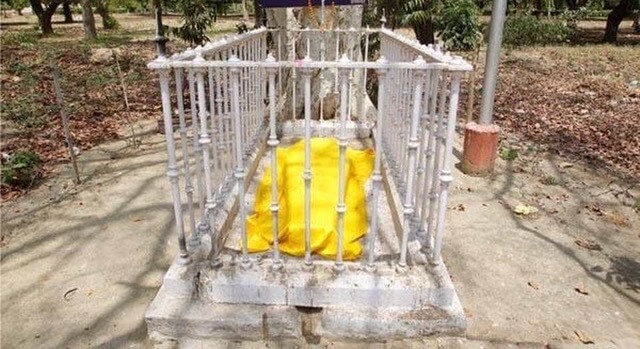THE MAZAAR OF SERGEANT WATKINS
‘On a recent visit to Allahabad I was shocked beyond words to find that in the famous Alfred Park the grave of G.R.Watkins, Quartermaster Sergeant of the 6th Regiment, killed on 6th June 1857 has been just razed to the ground and no trace left of it. The grave was in existence till recent weeks. Please keep me abreast of action being taken and let me know if I can be of assistance.’ This shocking piece of news was emailed to Chowkidar’s editor in November 2021 by Mr Gurpreet Singh Anand.
Alfred Park was named after Queen Victoria’s second son and had previously been called Company Bagh – the East India Company’s garden – an extensive site of 133 acres. (Today it is called the Chandra Shekhar Azad Park.) QM Sergeant George Richard Watkins, to give him his full name, is one of those Englishmen who have taken on a mysterious persona after death. His is not the first such tomb that has subsequently become a place of pilgrimage for Indian people. The story goes that he was known as Richard Sahib, and also as Richard-ud-din (‘Richard of the Faith’). Among some circles in Allahabad it is believed that he was ‘an English gentleman who decided to lead an austere life of spirituality and ultimately went on to become a revered saint’. It is not easy to reconcile this description with that of a QM sergeant, and it may be that confusion has arisen over an earlier Richard Sahib but nevertheless ‘the tomb is highly venerated as a mazaar (the grave of a holy man), by the locals who often come and mark their presence by paying regular homage’. The grave itself was a flat stone fenced with iron railings and a metal cross. (see page 58) As befits a holy man, the stone was covered with a silk cloth, and the inscription underneath read: ‘Sacred to the memory of George Richard Watkins Quarter-master Sergeant of the 6th Regiment who was killed on 6th June 1857. Aged 30 years, 1 month and 21 days.’ The 6th Bengal Native Infantry had initially supported its European officers as news of the rebel Uprising spread across northern India. But on the evening of 6th June the sepoys suddenly turned on their British officers and a number were killed, shot down on the parade ground. European women, children, male volunteers and army pensioners were already inside the Fort, but there was anarchy in the city itself as the jail was opened, the prisoners released and the treasury looted. Order was restored with the arrival of General Neill and his Madras troops five days later when the dead were retrieved and buried.
In trying to establish what had happened to Sergeant Watkins’ grave, Mr Anand put BACSA’s Secretary in touch with Mr Nilesh Narayan who runs a tour company specialising in ‘off-beat’ cities of Uttar Pradesh andwho has a keen interest in Alfred Park. Mr Narayan was able to unpick what had happened and to provide a possible remedy. A complaint about illegal encroachments in the Park had gone before the High Court of Allahabad. Encroachment is a serious problem in India and old Christian cemeteries are often the victims of the ‘land-mafia’ as the encroachers are called. In this case the High Court ordered that all encroachments in the Park that had taken place after 1975 were to be removed, including ‘graves and mazaars’. ‘Unfortunately,’ reports Mr Narayan ‘due to laxity of the authorities, the grave of Sergeant Watkins bore the consequences….the authorities went overboard to demolish a documented site.’ A few undocumented graves, believed to be those of Mewati Muslims who were killed fighting the British in 1857 were also lost. Mr Narayan proposes that the grave should either be reconstructed, or a memorial plaque placed nearby. Photographs show that although the site has been levelled, with the stone and railings removed, no disinterment appears to have taken place.

Dr Rosie Llewellyn-Jones MBE
Editor of ‘Chowkidar’
